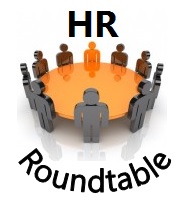When we got together for the August Cincinnati HR Roundtable, people were excited to talk about the topic more than usual. We were going to discuss feedback. The room was full of energy because people have had different experiences with feedback both positive and negative.
The attendees kicked off their small groups with the following questions:
- How do you define “feedback”?
- How and when is feedback typically given?
- How can we improve this and make it more consistent?
The energy level jumped even higher as they started to tackle the questions. It was hard to bring them back together to share, but once that happened they had great responses.
1. How do you define feedback?
The verbal, or nonverbal, exchange of information regarding behavior or performance – Woah! I asked if the group had looked up the definition on Google. This was so formal. They laughed and reminded me I had asked for a definition. Noted. This was a definition. Let’s move on
Feedback should be forward thinking — The key portion of this answer is “should be” because feedback normally is not forward thinking. This was a very positive suggestion though and a great approach to consider before delivering feedback to others. It would be great to ask if your feedback is forward thinking, or if it will lead to behavior changing moving forward.
Feedback should be constructive — Similar to the prior answer, “should be” was included because most of the attendees noted that when they received feedback it was not constructive. It was noted that people are often given feedback in a “compliment sandwich.” This is where you say something nice and not related, then bash someone with a negative comment, and then wrap it with another nicety. Don’t do this!
Intentional (and unintentional) — Feedback is constant even if it isn’t spoken. Our body language gives us away every time. It could range from a smile to an eyeroll, but your body betrays your intent to just keep your feedback to yourself. Since that is a fact, understand it and be more intentional and express what your body is already signaling.
Feedback should come from people at all levels — This may be an ideal to aspire to.Having feedback throughout every level of an organization would be fantastic. It may not occur now, but why not have a goal?
2. How and when is feedback typically given?
Engagement surveys (or so we think) — Many companies use surveys to solicit feedback from a large section of employees at one time. They have some value, but at the same time the feedback may not truly reflect how people feel. There is a tendency for people to give positive responses because they either don’t want to be bothered, or they feel compelled to do so. If you conduct surveys, use one that is more open-ended versus just checking boxes to make leadership feel good about itself.
Employee roundtables — This was a unique answer where a company has regular focus groups where employees share how things are going. This is more reflective of the culture of the company overall because they allow feedback to occur using this open method. It’s very cool and something to consider.
One-on-one using certain timeframes — It was encouraging to hear most of the attendees state that feedback occurs one-on-one. The challenge is that it also happens on more formal time frames and environments. The time frames noted included weekly, every six months or annually. When feedback is expected to be shared primarily as part of a program, it may lose its effectiveness because it wasn’t timely.
Performance reviews — This is where many organizations still stand. There is the feeling that formal reviews are the best time to give feedback. This is difficult to believe because people don’t remember what they did last week let alone over an entire year. We tabled the on-going conversations that started to arise from this answer because it could fill an entire Roundtable by itself.
3. How can we improve this and make feedback more consistent?
Feedback should be on-going — There’s that phrase again. “Should be” is needed because on-going feedback would be fantastic. It’s more effective both in the moment and over time. Try to eliminate formal get togethers as the main method to use. It’s better to be timely and share in the midst of what is occurring.
Use the three I’s — The group suggested that feedback needs to be Informal, Immediate and Instructive. These three I’s are a solid model to keep in mind because if you consider these three attributes, you will tend to be more consistent.
Let me know I’m doing well — To break the pattern and practice of giving negative feedback, you need to start with sharing when things are going well. Don’t just do it because you’re told to. Do this because it’s more effective than you think. People respond much better to praise than constant criticism.
Be empathetic (real definition – human!) — Understand that feedback is between two humans. We tend to make the conversation more about systems and things and we blow past that we’re two people who are interacting. Step back and assess how the person you’re going to deliver feedback to is ready to receive. Empathy is far more lasting than expediency.
Set expectations — Make feedback more of the fabric of your organization than a program. Set expectations for departments, working relationships and even the entire company that feedback is going to be your norm. This would be radical because it just isn’t done. Decide to set a new norm and break from tradition.
Steve closed the Roundtable by sharing a resource that he’s using at his company. It comes from Adobe. It’s a “Check-In” process that provides a system of intentional interactions, conversations and feedback. Adobe has allowed this approach to be open sourced and shared. So, here’s the link.
The Roundtable was wonderful once again and the feedback that was given before people left for the day confirmed that. The rest of 2018 should continue to be solid and I hope you can come to future Roundtables.
